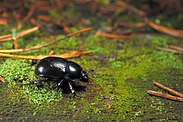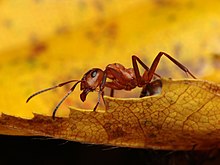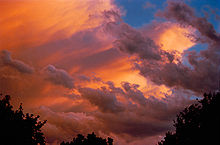| This article needs additional citations for verification. Please help improve this article by adding citations to reliable sources. Unsourced material may be challenged and removed. Find sources: "Nature photography" – news · newspapers · books · scholar · JSTOR (December 2019) (Learn how and when to remove this message) |

Nature photography is a wide range of photography taken outdoors and devoted to displaying natural elements such as landscapes, wildlife, plants, and close-ups of natural scenes and textures. Nature photography tends to put a stronger emphasis on the aesthetic value of the photo than other photography genres, such as photojournalism and documentary photography.
"Nature photography" overlaps the fields of—and is sometimes considered an overarching category including -- "wildlife photography," "landscape photography," and "garden photography".
Nature photographs are published in scientific, travel and cultural magazines such as National Geographic Magazine, National Wildlife Magazine and Audubon Magazine or other more specific magazines such as Outdoor Photographer and Nature's Best Photography. Well known nature photographers include Ansel Adams, Eliot Porter, Frans Lanting, Galen Rowell, and Art Wolfe.
Landscape Photography
Main article: Landscape photography
Landscape photography is one of the categories of photography often associated with nature photography. It focuses on images of the natural world (such as rivers, mountains, deserts, and forests) as well as man-made structures (such as city skylines). However, that is rarer and separated from nature photography. As such, landscape photography is an adjacent rather than a sub-category of nature photography.

Landscape photography aesthetics have changed throughout the decades based on the trends of the time. It is closely related to Landscape paintings and is often discussed in direct relation to it throughout its history.
As is the trend in much of nature photography, the focus of landscape photography is on the natural beauty of the world with little artificial lighting or staging. There are also forms of landscape photography that are seen as more artistic or abstract than others, though those seem to lean more towards a macro photography style.
Wildlife photography
Main article: Wildlife photography
Wildlife photography is all about capturing pictures of animals, especially those considered exotic, in their natural habitats, and so only became truly popular once cameras were portable. Depending on the purpose of the photograph and photographer, Wildlife photography can either portray the animals in action (such as eating, fighting, or in flight), or in more static and detailed poses for identification purposes. Much like in landscape photography, wildlife photography is also often used in magazines such as National Geographics to inform and inspire audiences.
Photographs taken of captive or controlled animals are not considered wildlife photography as by definition from the Photographic Society of America, the Fédération Internationale de l'Art Photographique and the Royal Photographic Society. According to these three worlds largest photography societies the definition for wildlife photography, that will be applied to photography competitions, is photos taken of any zoological of biological organism (including fungi and algae), in a uninhibited (wild) environment.

The techniques of wildlife photography differ greatly from those used in landscape photography. For example, in wildlife photography wide apertures are used to achieve a fast shutter speed, freeze the subject's motion, and blur the backgrounds, while landscape photographers prefer small apertures to keep the entire frame in focus. Wildlife is also usually shot with long telephoto lenses from a great distance; the use of such telephoto lenses frequently necessitates the use of a tripod (since the longer the lens, the harder it is to handhold). Many wildlife photographers also use blinds or camouflage in order to get closer to their subjects and capture more appealing shots without scaring the animals or causing a shift in behavior in them, a method that was developed early on, since camera lenses were not developed enough to take quality photos over long distances.
History

The origins of wildlife photography can be traced back to the early days of photography in the mid-19th century. One of the earliest known wildlife photographs was taken by British photographer Cherry Kearton in 1892, who captured the first photograph of a bird’s nest with eggs. Kearton and his brother Richard were pioneers of wildlife photography, and their images of birds were used to produce the first-ever nature photography book “British birds’ nests: how, where and when to find and identify them.” The brothers’ innovative portraits of animals and safaris to the savannahs of Africa helped to popularize the genre.
In the early 20th century, photographer and US Representative from Pennsylvania, George Shiras III, revolutionized wildlife photography when he began using camera traps and flash photography to capture images of wildlife in the dark. Deemed "the father of wildlife photography" by National Geographic, Shiras was an avid conservationist and believed wildlife photography was “an irreplaceable medium for revealing the unknown and attesting to the beauty of an endangered world.” While Shira initially exploded magnesium powder to create the flash effect and a suspended rope to trigger his flashlight trap, these methods have been refined and standardized in the decades since. In July 1906, a photograph Shiras captured of three deer at night became the first wildlife photo to be featured in National Geographic.
In the mid-20th century, wildlife photography began to gain wider recognition as a legitimate form of artistic expression. Photographers like Peter Beard and Art Wolfe began to use wildlife photography as a means of conservation, using their images to raise awareness about the need to protect endangered species and their habitats.
Macro photography
Main article: Macro photographyMacro photography (photomacrography, macrography, or macrophotography) is extreme close-up photography of nature, typically including insects, plants, and other items. It focuses on tiny living organisms and shows details not typically seen. Macro photography typically includes equipment made for an extremely detail-oriented approach.

The macro photography article explains close-up photography in general; however, this is also a type of nature photography. While common macro subjects – bees, dragonflies, and so on – could be described as wildlife, their world also makes for good photography.
Many photographers record images of the texture in a stone, tree bark, leaf, or any of other small scenes. Many of these images are abstract. Tiny plants and mushrooms are also popular subjects. Close-up nature photography doesn't always need a true macro lens; however, the scenes here are small enough that they are generally considered different from regular landscapes.
Macro photography employs texture and close-up photography to allow people to see things they wouldn’t be able to see with the naked eye and create a new perspective for viewers.
Cloudscape photography
Main article: Cloudscape photographyCloudscape photography or cloud photography is the photography of the clouds or sky.


Cloudscape photography allows photographers to capture photographs of clouds' movement and dynamic nature. It is ever-changing and seen often in photography. Clouds and their fickle nature create an outlet for photos to appear more dramatic and intense. Cloudscape photography can be used in tandem with many other types of nature photography, including landscape, storm, animal, outdoor architectural, and plant photography.
It is a versatile type of photography often seen in collage work and other artistic outlets.
Clouds come in many shapes and types, including cumulus, cumulonimbus, stratus, and stratocumulus. These different varieties allow photographers to take in various styles and concepts. Cloudscape photographers will also focus on the time of day and weather they photograph to achieve different effects.
Camera choice, filter style, and equipment within cloudscape photography are similar to general nature photography. However, it is up to the personal preference of the photographer.
Leonard Misonne (1870-1943) is accredited as an early cloudscape photographer with his collection of cloudscape photos called "equivalents." This was one of the first notable collections focused solely on cloudscape photography. Other notable cloudscape photographers include Ralph Steiner, Robert Davies, and Tzeli Hadjimitriou.
Use of color
Color images are not a requirement of nature photography. Ansel Adams is famous for his black-and-white depictions of nature, while Galen Rowell praised Fujifilm Velvia film for its bright, saturated colors, asking "Who wants to take dull pictures that will last a hundred years?" Both men distinguish between photography as an expressive art form and sensitometry; an accurate reproduction is not necessary.
Nature Photography Awards
- Wildlife Photographer of the Year: Beginning in 1964, this competition has been described as the world’s most prestigious wildlife prize. The competition is held annually by the Natural History Museum in London, England, and includes 15 categories of prizes. The winners are featured in an exhibition put on display at the museum, and the photographs are later toured around the world. The 2022 grand title winner was Karine Aigner for her photograph of a ball of cactus bees.
- National Geographic Pictures of the Year: As one of the most respected and well-known organizations for nature photography, National Geographic began its “Pictures of the Year” contest in 2023. It invites photographers, both amateur and professional, to submit photos to compete in one of four categories: nature, people, places, and animals.
Ethics
A number of ethical concerns and debates surround the creation of nature photography. Common issues involve the potential of stress or harm to wildlife, the potential of photographers overrunning and destroying natural areas, the use of game farms, and veracity and manipulation in photography. Also the information posted by photographers on social media of the location of endangered species leads to poachers using this information to hunt these animals.
See also
References
- ^ Purdue Univ., "Nature and Landscape Photography" Archived 2015-10-07 at the Wayback Machine, from Visualizing Nature: Promoting Public Understanding and Appreciation of Nature, Earth, Atmospheric, and Planetary Sciences, Purdue University, West Lafayette, Indiana, retrieved October 4, 2015.
- Nashville Film Institute. "Landscape Photography – Everything You Need To Know". NFI. Retrieved 18 March 2023.
- ^ Jussim, Estelle; Lindquist-Cock, Elizabeth (1985). Landscape As Photograph. Yale University Press. pp. 1–2.
- ^ Lenman, Robin; Nicholson, Angela (2005). Nicholson, Angela (ed.). "The Oxford Companion to the Photograph (Wildlife)". Oxford Reference. Oxford University Press. doi:10.1093/acref/9780198662716.001.0001. ISBN 978-0-19-866271-6. Retrieved 19 March 2023.
- "The Keartons: inventing nature photography – in pictures". the Guardian. 2016-07-14. ISSN 0261-3077. Retrieved 2023-03-20.
- "Photography pioneers who inspired Sir David Attenborough". Gazette & Herald. Retrieved 2023-03-20.
- "Meet Grandfather Flash, the Pioneer of Wildlife Photography". Photography. 2015-11-20. Archived from the original on February 25, 2021. Retrieved 2023-03-20.
- "Milestones in Wildlife Photography -- National Geographic". Photography. 2009-05-11. Archived from the original on March 9, 2021. Retrieved 2023-03-20.
- "The Legend of Peter Beard". Vanity Fair. 2020-09-24. Retrieved 2023-03-20.
- "Meet a traveller: Art Wolfe, photographer and conservationist". Lonely Planet. Retrieved 2023-03-20.
- Thomas Clark (2011). Digital Macro and Close-Up Photography For Dummies. John Wiley & Sons. p. 29. ISBN 978-1-118-08920-0.
- "What is macro photography & what is it used for? | Adobe". www.adobe.com. Retrieved 2022-11-30.
- "What is macro photography & what is it used for? | Adobe". www.adobe.com. Retrieved 2022-12-09.
- "Abstract Photography Movement Overview". The Art Story. Retrieved 2022-12-09.
- "Thinking small for a big impact with macro photography". Adobe. Retrieved 20 March 2023.
- ^ "How to photograph clouds". Photography life. Retrieved 20 March 2023.
- Wilcox, E. M. (2008). Clouds. Duncan Baird
- Bacon, J. M. (1900). Cloud photography from balloons. Aeronautical Journal (London, England : 1897), 4(16), 146–148. https://doi.org/10.1017/S2398187300146511
- "Leonard Missone". Artnet. Retrieved 20 March 2023.
- Galen Rowell's Vision, Galen Rowell, ISBN 0-87156-357-6
- Chrisafis, Angelique; correspondent, arts (2002-09-17). "Wildlife photographers feted for animal pageantry". The Guardian. ISSN 0261-3077. Retrieved 2023-03-20.
{{cite news}}:|last2=has generic name (help) - "Wildlife Photographer of the Year winners go deep to see our planet's inner beauty". The Globe and Mail. 2022-10-12. Retrieved 2023-03-20.
- Janean (2023-02-17). "NATIONAL GEOGRAPHIC ANNOUNCES WINNERS OF PICTURES OF THE YEAR PHOTO CONTEST". National Geographic Partners. Retrieved 2023-03-20.
- Nicholls, Will (2014-05-22). "An Ethical Guide to Wildlife Photography". Nature TTL. Retrieved 2019-08-04.
- Podduwage, Divanka; Ratnayake, Patrick (16 October 2020). "Wildlife Photography over Nature Photography". The International Journal of Social Sciences and Humanities Invention. 09: 49–52. doi:10.35629/7722-0909024952 (inactive 1 November 2024) – via ResearchGate.
{{cite journal}}: CS1 maint: DOI inactive as of November 2024 (link) - Nicholls, Will (2017-10-30). "Photographers: Strip GPS Data from Your Photos to Protect Wildlife". Nature TTL. Retrieved 2019-08-04.
External links
| Environmental humanities | ||
|---|---|---|
| Art |  | |
| Culture | ||
| Literature | ||
| Philosophy | ||
| Religion | ||
| Other | ||
| Related | ||
| Applied | ||
| ||